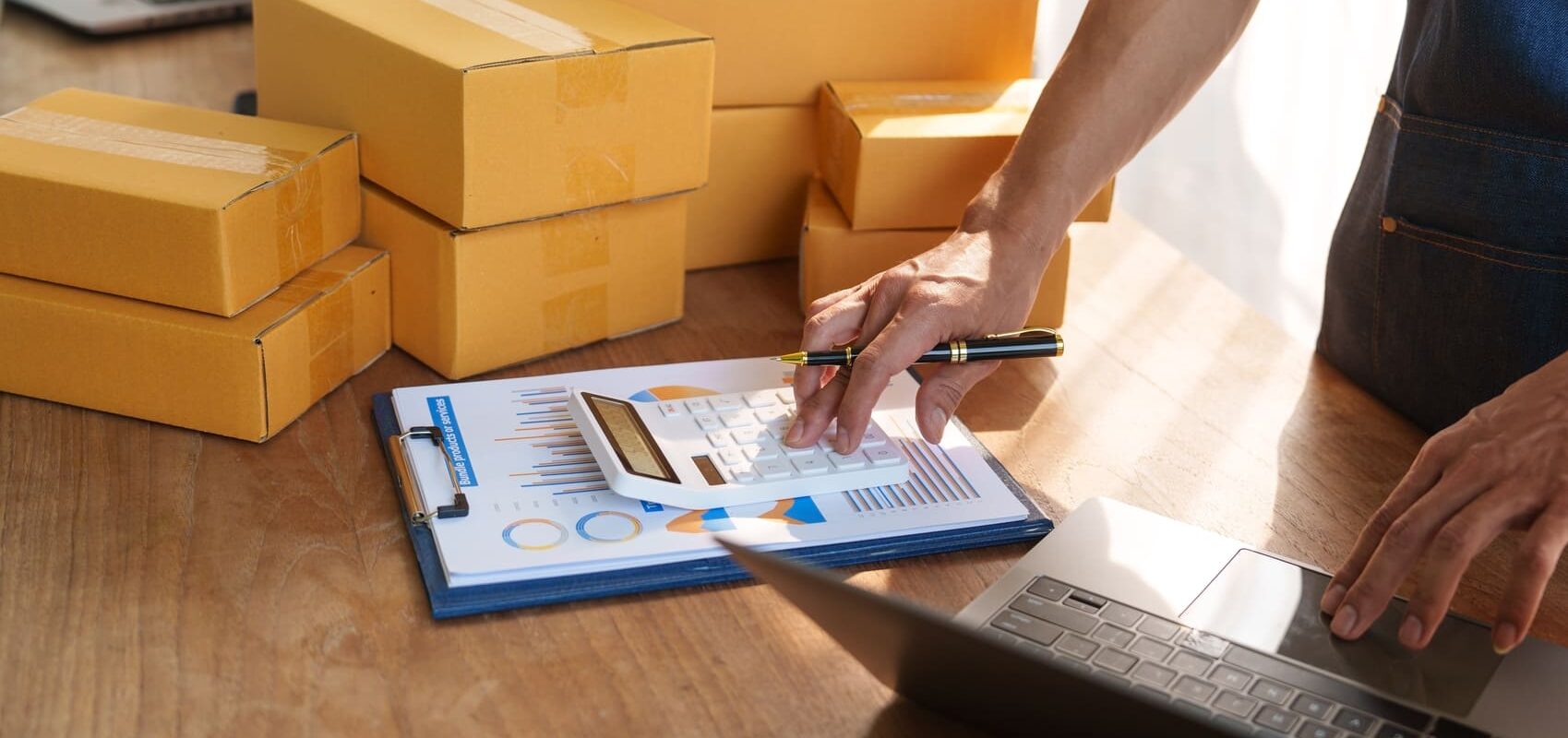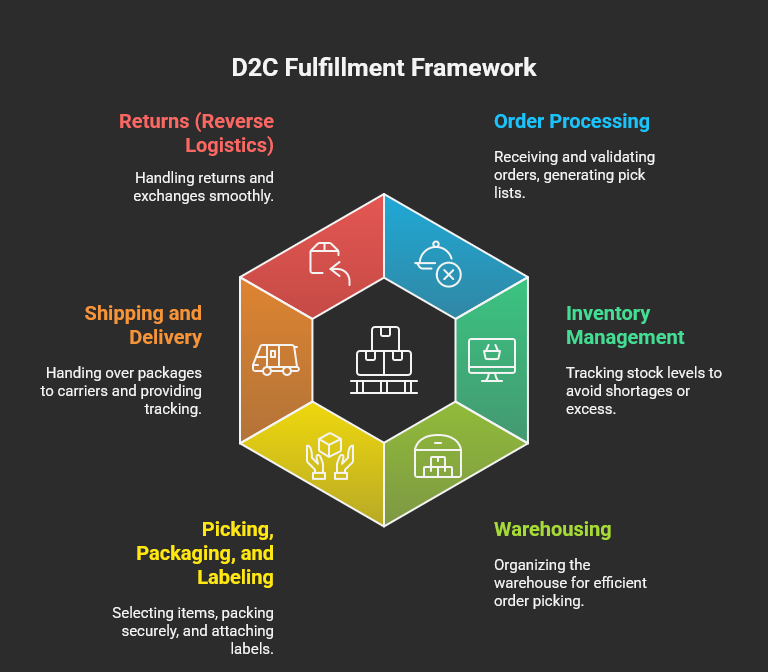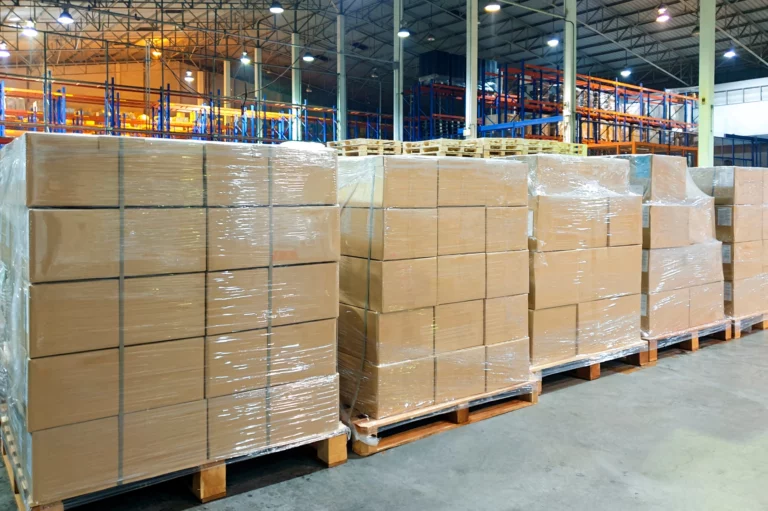Direct-to-Consumer (D2C) Fulfillment Guide

Direct-to-consumer (D2C) fulfillment means shipping products directly from a brand’s own warehouse or fulfillment center straight to the customer. This direct shipping model bypasses traditional retailers and distributors, giving brands full control over packaging, shipping speed, and the customer experience. By eliminating middlemen and retail markups, D2C fulfillment can improve profit margins and strengthen customer loyalty. Today, many e-commerce brands tap into the growing direct-to-customer outsourced fulfillment market, choosing third-party fulfillment centers and 3PLs to scale quickly without owning warehouse space.
In this comprehensive guide, we’ll explain the D2C fulfillment model, explore its key processes and benefits, and outline the different fulfillment options (from in-house to outsourced services). We’ll also cover common challenges and best practices, including how to choose the right fulfillment center or provider for your D2C business. Whether you sell online via Shopify, WooCommerce, Amazon, or your own site, this guide will help you understand how to efficiently fulfill direct-to-customer orders.
What is Direct-to-Consumer Fulfillment?
In a D2C fulfillment model, when a customer places an order, the brand processes that order and ships products directly from its warehouse to the buyer’s doorstep. Unlike traditional retail logistics, this consumer-direct approach skips intermediaries like distributors and stores, reducing costs and lead times. The manufacturer or brand handles everything from inventory and order management to packaging and last-mile delivery.
This direct relationship allows brands to control every aspect of the fulfillment experience. For example, a company can customize packaging, include branded inserts, and tailor delivery options to match its brand values. D2C fulfillment also provides rich data on customer preferences, since brands interact directly with end buyers during each transaction. In short, D2C fulfillment enables a brand to manage orders from the moment of purchase through delivery, maximizing control over the entire process and customer satisfaction.
Benefits of D2C Fulfillment
Selling direct-to-consumer offers several strategic advantages over traditional retail distribution:
- Brand Control & Experience: Handling fulfillment in-house or through a dedicated D2C fulfillment center lets brands ensure that packaging, delivery speed, and service levels reflect their own standards. Customized packaging and inserts can be used to reinforce branding and create a memorable customer experience.
- Higher Profit Margins: By shipping products directly to customers and bypassing wholesalers or big-box retailers, brands avoid retailer markups. This means more profit per sale, which can be reinvested in marketing or product development.
- Customer Insights & Loyalty: Direct sales provide valuable customer data. Brands learn who is buying, how often, and what they prefer. This insight enables personalized marketing and faster product innovation. Over time, a direct relationship can strengthen customer loyalty.
- Faster Time-to-Market: New products can be launched online immediately without waiting for retailers to stock shelves. Brands can quickly test new items, adjust inventory, and respond to market trends.
These factors make D2C fulfillment an attractive strategy for many e-commerce businesses. U.S. D2C sales are growing rapidly, with revenue projected to exceed $212 billion in 2025. Efficient D2C logistics are critical to capturing this market.
Core D2C Fulfillment Processes
Successful D2C fulfillment depends on seamless coordination of several core processes:
- Order Processing: Receiving orders from websites or apps, validating payment, and generating pick lists.
- Inventory Management: Businesses track inventory levels using software to avoid stockouts or excess stock and ensure products are available when needed.
- Warehousing: Organizing products efficiently in a warehouse allows fast picking and packing. A well-structured fulfillment center with clear inventory locations speeds up order handling.
- Picking, Packaging, and Labeling: Physically selecting the items for each order, packing them securely, and attaching carrier labels. Accuracy in this step is vital – mistakes lead to returns and upset customers.
- Shipping and Delivery: Once packed, products are handed over to carriers like FedEx for delivery, with tracking information provided to customers.
- Returns (Reverse Logistics): Efficiently processing returns and exchanges is part of the D2C promise. Brands must handle returned items, issue refunds or replacements, and restock goods while minimizing hassle for the customer.
Automating the flow of data between your e-commerce platform and your warehouse management system (WMS) is critical for efficiency. For example, syncing your Shopify or Amazon store directly to the fulfillment center’s system eliminates manual data entry and speeds up order fulfillment. A streamlined process from order capture to delivery is key to a satisfying D2C customer experience.

Challenges of D2C Fulfillment
While the benefits are clear, D2C fulfillment also brings challenges:
- Rapid Scalability: Managing sudden spikes in demand can strain a business. It’s hard to quickly scale your own order fulfillment when sales surge. Without a plan, a growth spike can lead to delays or stockouts.
- Inventory Forecasting: Predicting the right stock levels is tricky. Under-forecasting leads to lost sales; over-forecasting ties up capital in excess inventory. Maintaining accurate demand forecasts is critical.
- Last-Mile Delivery: Shipping each order to individual customers is costlier per item than bulk shipments to retailers. Brands must optimize carriers and routes to keep costs reasonable while meeting customer expectations for fast delivery.
- Returns Management: D2C models usually include easy returns (since customers expect it). Handling returns efficiently (processing refunds, restocking goods) adds complexity and cost to fulfillment.
- Technology Integration: Selecting and implementing the right software (e.g. order management, inventory tracking, CRM) can be complex and expensive. But it’s necessary for scaling, manual systems won’t suffice when order volumes grow.
- Customer Expectations: Today’s customers expect quick, free shipping and real-time tracking. Meeting these expectations in-house can be difficult. Falling short on speed or accuracy can damage a brand’s reputation.
In short, managing all fulfillment steps internally can be risky for fast-growing D2C brands. Common challenges include last-mile logistics, inventory forecasting, and reverse logistics (returns). Brands must have robust processes or partners to handle these complexities.
Fulfillment Options for D2C Businesses
- In-House Fulfillment: The company stores products in its own warehouse(s) and handles all picking, packing, and shipping. This offers maximum control but requires significant investment in space, Many startups start this way, but it becomes hard to maintain as volume grows.
- Third-Party Logistics (3PL): Partnering with a 3PL provider allows businesses to outsource warehousing, order processing, and shipping. This option is scalable, cost-effective, and reduces the need for in-house logistics management.
- Dropshipping: The brand takes orders on its site, but the supplier (or manufacturer) ships directly to the customer. This requires no inventory investment, but the brand has less control over shipping speed and quality. Dropshipping typically yields thinner margins since the supplier handles fulfillment.
- Fulfillment by Amazon (FBA): If selling on Amazon, a brand can use Amazon’s network. With FBA, inventory is shipped to Amazon’s warehouses, and Amazon picks, packs, and delivers orders (including Prime shipping). This taps into Amazon’s 147 million Prime customers and fast delivery network, but has drawbacks: Amazon packaging, fees, and strict requirements
- Hybrid Fulfillment Model: Combining in-house fulfillment with 3PL or dropshipping can offer flexibility. Businesses can fulfill high-demand products in-house while outsourcing other items to a 3PL or dropshipping partner.
- Ship-from-Store: For retailers with physical locations, fulfilling orders from stores can speed up delivery times and reduce costs. It leverages existing inventory and facilities to fulfill online orders.
- Automated Fulfillment: Using automated technologies like robots and AI for picking, packing, and inventory management can improve speed and accuracy. Automated fulfillment systems are ideal for high-volume businesses but require significant upfront investment.
Each option has trade-offs. Many successful D2C brands eventually partner with a 3PL for core fulfillment, since it offloads complexity.
Advantages of a 3PL Partner for D2C Fulfillment
- Scalability: 3PL providers can handle increased order volumes during peak seasons or as your business grows, allowing you to scale operations without investing in additional infrastructure or staffing.
- Cost-Effectiveness: By outsourcing warehousing, order processing, and shipping to a 3PL, businesses can reduce costs associated with labor, warehouse space, and shipping. 3PL providers often have negotiated rates with carriers, leading to reduced shipping costs.
- Expertise and Technology: 3PL providers specialize in logistics and often use advanced technology like inventory management systems, order tracking, and automated processes to improve efficiency and accuracy.
- Faster Shipping: 3PLs typically have multiple fulfillment centers across regions, enabling faster and more cost-effective shipping to customers. This helps meet growing customer expectations for faster delivery times.
- Focus on Core Business: Outsourcing fulfillment allows companies to focus on their core competencies such as product development, marketing, and customer service, instead of logistics and supply chain management.
- Flexibility: A 3PL can offer flexible solutions based on business needs, whether it’s managing seasonal fluctuations, international shipping, or handling returns.
- Risk Reduction: 3PLs help manage risks like inventory inaccuracies, shipping delays, and regulatory compliance issues, giving businesses peace of mind while focusing on growth.
Choosing the Right D2C Fulfillment Provider
When selecting a direct-to-consumer fulfillment provider or service, consider:
Customer Service: Choose a provider that acts as a partner. A dedicated account manager and responsive support team can make all the difference when issues arise.
Scalability & Locations: Ensure they have the capacity and locations to grow with you. Check the provider’s warehouse network and geographic coverage. A nationwide or global network enables faster delivery to customers in different regions.
Technology Integration: The fulfillment center should integrate seamlessly with your e-commerce platforms (Shopify, WooCommerce, Amazon, etc.) and with back-office systems (ERP, inventory software). Real-time inventory syncing, order tracking, and API/EDI connections are crucial to avoid manual errors.
Reputation and Accuracy: Research their track record for order accuracy and on-time delivery. Read reviews or case studies. Some 3PLs (like Red Stag) even offer fulfillment guarantees on accuracy to prove confidence.
Flexible Services: Look at the range of services they provide. Does the provider handle returns, product kitting, or customized packaging and gift options? The more comprehensive their services, the more you can offload to them.
Cost Structure: Seek clear, all-inclusive pricing. Avoid hidden fees. A good partner will typically charge per pick, pack, and ship with a simple fee structure.
By vetting these factors, you can choose a fulfillment partner that fits your D2C business model and helps deliver a superior customer experience.
Implementing a D2C Fulfillment Strategy
- Assess Your Needs: Evaluate your current fulfillment process and identify areas for improvement.
- Choose the Right Technology: Invest in systems like order management, inventory tracking, and CRM tools to streamline operations.
- Partner with the Right Fulfillment Provider: Select a reliable provider with the right services and a proven track record.
- Optimize Your Supply Chain: Streamline processes to reduce costs and improve efficiency with lean practices.
- Focus on Customer Experience: Provide a seamless shopping experience with personalized features that drive loyalty.
- Monitor and Adjust: Regularly assess your fulfillment process and adjust based on customer feedback and performance metrics for continuous improvement.
Conclusion
Direct-to-consumer fulfillment is a powerful strategy for brands looking to strengthen customer relationships and improve their market presence. By handling orders internally or with a dedicated fulfillment center, companies gain greater control over the entire process from inventory to delivery. While D2C logistics can be complex, understanding the key processes and challenges allows brands to build an effective fulfillment strategy.
For North American businesses, Olimp’s warehousing and fulfillment network provides flexible, on-demand infrastructure to support D2C needs. Olimp offers a continent-wide network of secure warehouses and fulfillment centers, allowing you to store inventory near customers and ship orders quickly. With advanced management systems and dedicated support, Olimp enables D2C brands to scale operations without heavy upfront investment.
Whether you choose to handle fulfillment in-house or partner with a 3PL, following D2C best practices will help your e-commerce business grow. With the right strategy and support, your direct-to-consumer channel can drive higher margins, loyalty, and long-term success.
Let’s build a fulfillment solution that fits your growth.
✨ Request a Quote
Olimp’s logistics team is ready to help you create a D2C fulfillment strategy that lowers costs, improves delivery speed, and elevates your customer experience.
Frequently Asked Questions (FAQ) – OLIMP Warehousing
Q: Where should D2C brands store and ship their inventory?
Direct-to-consumer brands often use dedicated warehouses or fulfillment centers to store and ship inventory. For example, Olimp’s on-demand warehousing network provides pallet-by-pallet storage in thousands of locations across North America. Using local fulfillment centers lets D2C brands keep products closer to customers and fulfill orders faster.
Q: What should I look for in a D2C fulfillment provider?
Key factors include strong customer support, scalability, and technology integration. A good provider should offer a dedicated account manager, a nationwide warehouse network, and seamless integration with your sales platforms (Shopify, Amazon, etc.). Check their track record for accuracy and consider the range of services they offer (returns handling, kitting, custom packaging). Transparent pricing and flexible terms are also important.
Q: What are must-have WMS features for a D2C brand?
A DTC-focused warehouse management system should include real-time inventory tracking and integration with all sales channels. Key features include barcode scanning, automated picking and packing lists, multi-channel inventory synchronization, and support for high-volume e-commerce shipping. These features ensure accurate stock levels and efficient processing of online orders.
Q: How does D2C fulfillment differ from traditional retail logistics?
Traditional retail logistics typically involve shipping large quantities of products to retailers or distribution centers, which then handle selling to consumers. D2C fulfillment, by contrast, ships individual orders directly to customers’ addresses. This means the brand manages the entire end-to-end process, including last-mile delivery and direct customer communication, rather than relying on retailer partners.
Q: Which D2C fulfillment options scale best with growth?
Outsourced options like 3PL fulfillment or hybrid models tend to scale well. A 3PL can quickly add warehouse space and staff as your order volume grows. Similarly, hybrid fulfillment (using both in-house and 3PL) offers flexibility. For very high volumes, automated fulfillment technologies can also scale efficiently. Overall, partnering with an established 3PL provides the most cost-effective scalability since they already have infrastructure and systems in place.
Q: Who offers end-to-end fulfillment for D2C brands?
Many logistics providers specialize in direct-to-consumer fulfillment. Look for national or regional 3PLs that market themselves as D2C experts. OLIMP Warehousing is one example: it offers warehousing, order processing, shipping, and returns services specifically designed for e-commerce brands. These providers receive and store your inventory in their facilities, then pick, pack, and deliver customer orders as they come in, allowing you to focus on selling your products.
You may be interested in

4PL Logistics: The Ultimate Guide to Fourth-Party Logistics
Fourth-party logistics (4PL) refers to hiring a single partner to integrate and manage an entire supply chain. In practice, a 4PL provider acts as a strategic supply chain integrator, overseeing transportation, warehousing, inventory, and fulfillment on behalf of a company. In other words, businesses outsource their full logistics management to one expert who coordinates multiple […]

Guide to Choosing the Right Fulfillment Partner
What Is a Fulfillment Partner? A fulfillment partner (often a 3PL or fulfillment company) is a specialist third-party logistics provider that manages the entire order process on behalf of an online retailer. In practice, a fulfillment partner receives and stores your inventory in its warehouse, then picks, packs, and ships customer orders as they come […]

Fulfillment and Logistics: The Ultimate Guide to Efficient Order Fulfillment
Efficient fulfillment and logistics are the lifeblood of any successful e-commerce business. In simple terms, fulfillment logistics covers every step from receiving an order to delivering it to the customer – including inventory management, order processing, picking and packing, shipping, and even handling returns. When these steps run smoothly, customers get their orders accurately and […]
Ready to streamline your warehousing needs?
Request a quote today and discover how OLIMP's tailored solutions can optimize your operations